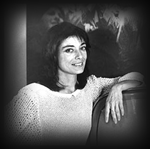Sherrie Rabinowitz (1950–2013)[1] was an American video artist and a pioneer in satellite-based telecommunications art. She worked exclusively with Kit Galloway under the moniker Mobile Image from 1977 onwards. She co-founded the Electronic Café International (ECI), a performance space and real café housed in the 18th Street Arts Center in Santa Monica, California, with Galloway.[2] She died in 2013, from complications due to multiple sclerosis.[1]
Sherrie Rabinowitz | |
|---|---|
 | |
| Born | January 6, 1950 |
| Died | April 8, 2013 |
| Nationality | American |
| Known for | Video Art |
| Partner | Kit Galloway |
Career
editOptic Nerve
editShe studied at University of California Berkeley and was involved in the collective Optic Nerve,[3] which created underground video and guerrilla television. Optic Nerve was one of the few San Francisco video collectives with women members in the 1970s.[4] As part of Optic Nerve she collaborated with the architecture and performance collective Ant Farm which was also based out of San Francisco. These projects include: Media Burn (1975), The Eternal Frame (1975), and Pier 40 Fire Clean Up (1978).[5]
Mobile Image
editFrom the mid-1970s onwards, Kit Galloway and Sherrie Rabinowitz created numerous art works which could be categorized as communication aesthetics, telecollaborative art, telematic art, cyber art, and digital theatre.[6] One example of their work is the 1977 Satellite Arts Project: A Space with No Boundaries, which created composite images of two dancers in California and two dancers in Maryland, and was supported by NASA.[7] Another example is their 1980 satellite relay project Hole-in-Space which connected public spaces in New York and Los Angeles with live audio and life-sized video.[8] Rabinowitz coined the phrase "We must create at the same scale that we can destroy"[9] which would become the headline of Mobile Image's manifesto[10] for their Electronic Cafe Network Project (1984) commissioned for the 1984 Los Angeles Summer Olympics Art Festival.
References
edit- ^ a b "Media pioneer Sherrie Rabinowitz passes". Dr. Future Show.com. Retrieved 6 March 2015.
- ^ Huffman, Kathy Rae. "Video and Architecture: Beyond the Screen." Ars Electronica: Facing the Future, a Survey of Two Decades (1999): 135-39.
- ^ Durland, Steven (1987). "Defining the Image As Place: A Conversation with Kit Galloway, Sherrie Rabinowitz & Gene Youngblood". Retrieved March 7, 2020.
- ^ Hanley, Joann, "Women, Art, and Technology: A Brief History" in Art, Women, California 1950-2000: Parallels and Intersections, eds. Diana Burgess Fuller, Daniela Salvioni, Deborah Munk, Gail Tsukiyama (Berkeley: University of California Press, 2002), 317.
- ^ Lewallen, Constance M.; Seid, Steve (2004). Ant Farm: 1968-1978. Berkeley and Los Angeles: University of California Press. pp. 169–170. ISBN 0-520-24029-4.
- ^ Wilson, Stephen (2002). Information Arts: Intersections of Art, Science, and Technology. MIT Press. ISBN 9780262731584.
- ^ Shanken, Edward A.; Ascott, Roy (2003). Telematic Embrace: Visionary Theories of Art, Technology, and Consciousness. Berkeley: CA: University of California Press. p. 60. ISBN 9780520218031.
- ^ "Satellite Arts Project 1977". Electronic Cafe. Retrieved 2008-09-23.
- ^ Youngblood, Gene (2020). Expanded Cinema: Fiftieth Anniversary Edition. New York: Fordham University Press. pp. xxv. ISBN 9780823287413.
- ^ "A Manifesto For The Original 1984 Electronic Cafe Network Project". Electronic Cafe. Retrieved April 6, 2020.